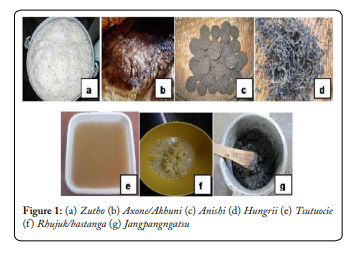
Ethnic food fermentation process forms one of the oldest methods of food preparation and preservation which not only increases the shelf life of the food but have benefits of improving the physiochemical characteristics and nutritional quality.
The major objective of this study was to document indigenous knowledge of ethnic people of Nagaland on production of some of the popularly consumed fermented food products, analyse the nutritional value and to isolate, characterise and identify the dominant microorganisms of five fermented food products viz, axone/akhuni, anishi, hungrii, rhujuk/bastanga and tsutuocie. A total of 25 samples of axone/akhuni, anishi, hungrii, rhujuk/bastanga and tsutuocie were analyzed for the microbial population.
On the basis of a combination of phenotypic and genotypic characterization, Bacillus species was found to be the most dominant microorganism in most of the foods. Axone/akhuni and tsutuocie were found to be alkaline in nature with a pH of 8.0 and 8.2. Anishi and hungrii had lower pH of 5.8 and 5.2, whereas Rhujuk/bastanga was acidic (4.7).
The protein content in axone, anishi, hungrii and rhujuk were in the range of 42-38.9g/100g, whereas the protein content in tsutuocie was found to be as low as 3.2g/100g. The crude fibre content in anishi was found to be higher compared to the other fermented products.
Of the five fermented food products it was observed that rhujuk had the highest level of phenolic content, followed by hungrii, anishi and axone, while lowest was in tsutuocie.The total flavonoid content in anishi was highest, followed by hungrii, axone and rhujuk whereas lowest was in tsutuocie. Maximum antioxidant activity was recorded in anishi, followed by hungrii, rhujuk and axone. Lowest antioxidant activity was recorded in tsutuocie.
Download the full article.
Ethnic Fermented Food Products of Nagaland India.pdf (319.4 KB)
Citation: Deb CR, Bendangnaro J. 2020. Ethnic Fermented Food Products of Nagaland, India. J
Food Chem Nanotechnol 6(1): 18-27.
Copyright: © 2020 Deb and Bendangnaro. This is an Open Access article distributed under the
terms of the Creative Commons Attribution 4.0 International License (CC-BY)
(http:// creativecommons.org/licenses/by/4.0/) which permits commercial use, including reproduction,
adaptation, and distribution of the article provided the original author and source are credited.
Published by United Scientific Group
